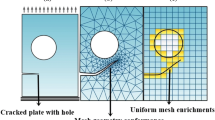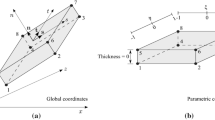Abstract
In this work the capabilities of an interface model to predict failure behavior of steel fiber reinforced cementitious composites (SFRCCs) are evaluated at both macro and mesoscale levels of observation. The interface model is based on a hyperbolic maximum strength criterion defined in terms of the normal and shear stress components acting on the joint plane. Pre-peak regime is considered linear elastic, while the post-peak behavior is formulated in terms of the fracture energy release under failure mode I and/or II. The well-known “Mixture Theory” is adopted for modeling the interactions between fibers and the surrounding cementitious composite. The effects of both the axial forces on the fibers induced by normal relative displacements, as well as the dowel action due to tangential relative displacements in the interfaces are considered in the formulation of the interaction mechanisms between fibers and cementitious composites. After describing the interface model, this work focuses on numerical analyses of SFRCC failure behavior. Firstly, the validation analysis of the interface model is performed at the constitutive level by comparing its numerical predictions against experimental results available in scientific literature. Then, the sensitivity of the interface theory for SFRCC regarding the variation of main parameters of the composite constituents is evaluated. Finally, the attention is focused on Finite Element (FE) analysis of SFRCC failure behavior at meso and macroscopic levels of observation. The results demonstrate the capabilities of the interface theory based on the Mixture Theory to reproduce the main features of failure behavior of SRFCC in terms of fiber content and involved fracture modes.
Similar content being viewed by others
References
Armero F, Linder C (2009) Numerical simulation of dynamic fracture using finite elements with embedded discontinuities. Int J Fract 160: 119
Barros J, Figueiras J (1999) Flexural behavior of SFRC: testing and modeling. ASCE J Mater Civil Eng 11(4): 331
Bazant Z, Oh B (1983) Crack band theory for fracture of concrete. Mater Struct 16: 155
Bazant Z, Tabbara M, Kazemi M, Pijaudier-Cabot G (1990) Random particle model for fracture of aggregate or fiber composites. ASCE JEM 116: 1686
Belytschko T, Lu Y, Gu L (1995) Crack propagation by element-free Galerkin methods. Eng Fract Mech 51(2): 295
Bilal E-A (2007) Behavior of beams with dowel action. Eng Struct 29(6): 899
Buratti N, Mazzotti C, Savoia M (2011) Post-cracking behaviour of steel and macro-synthetic fibre-reinforced concretes. Constr Build Mater 25: 2713
Caggiano A, Etse G, Martinelli E (2011) Interface model for fracture behaviour of fiber-reinforced cementitious composites (FRCCs): theoretical formulation and applications. Eur J Environ Civil Eng 15(9): 1339
Caggiano A, Etse G, Martinelli E (2012a) Zero-thickness interface model formulation for failure behavior of fiber-reinforced cementitious composites. Comput Struct 9899(0): 23
Caggiano A, Martinelli E, Faella C (2012) A fully-analytical approach for modelling the response of FRP plates bonded to a brittle substrate. Int J Solids Struct 49(17): 2291–2300
Caggiano A, Martinelli E (2012) A unified formulation for simulating the bond behaviour of fibers in cementitious materials. Mater Des. doi:10.1016/j.matdes.2012.05.003
Carol I, Prat P, Lopez C (1997) Normal/shear cracking model: applications to discrete crack analysis. ASCE JEM 123: 765
Carosio A, Willam K, Etse G (2000) On the consistency of viscoplastic formulations. Int J Solids Struct 37(48–50): 7349
Carpinteri A, Brighenti R (2010) Fracture behaviour of plain and fiber-reinforced concrete with different water content under mixed mode loading. Mater Des 31: 2032
Carpinteri A, Chiaia B, Nemati KM (1997) Complex fracture energy dissipation in concrete under different loading conditions. Mech Mater 26(2): 93
Comi C, Perego U (2001) Fracture energy based bi-dissipative damage model for concrete. Int J Solids Struct 38(36–37): 6427
de Borst R, Guitirrez M (1999) A unified framework for concrete damage and fracture models including size effects. Int J Fract 95: 261
de Borst R, Pamin J, Peerlings R, Sluys L (1995) On gradient-enhanced damage and plasticity models for failure in quasi-brittle and frictional materials. Comput Mech 17: 130
Dias-da Costa D, Alfaiate J, Sluys L, Jlio E (2010) A comparative study on the modelling of discontinuous fracture by means of enriched nodal and element techniques and interface elements. Int J Fract 161: 97
di Prisco M, Plizzari G, Vandewalle L (2009) Fibre reinforced concrete: new design perspectives. Mater Struct 42: 1261
Duan K, Hu X, Wittmann FH (2007) Size effect on specific fracture energy of concrete. Eng Fract Mech 74(1–2): 87
Dulacska H (1972) Dowel action of reinforcement crossing cracks in concrete. ACI Struct J 69(12): 754
Dvorkin E, Cuitino A, Gioia G (1990) Finite elements with displacement embedded localization lines insensitive to mesh size and distortions. Int J Numer Methods Eng 30: 541
Etse G, Nieto M, Steinmann P (2003) A micropolar microplane theory. Int J Eng Sci 41(13–14): 1631
Etse G, Willam K (1994) A fracture energy-based constitutive formulation for inelastic behavior of plain concrete. ASCE-JEM 120: 1983
Faella C, Martinelli E, Nigro E (2009) Direct versus indirect method for identifying FRP-to-concrete interface relationships. J Compos Constr 13(3): 226
Fantilli A, Vallini P, Chiaia B (2011) Ductility of fiber-reinforced self-consolidating concrete under multi-axial compression. Cem Concr Compos 33: 520
Ferrara L, Meda A (2006) Relationships between fibre distribution, workability and the mechanical properties of SFRC applied to precast roof elements. Mater Struct 39: 411
Ferro G, Carpinteri A, Ventura G (2007) Minimum reinforcement in concrete structures and material/structural instability. Int J Fract 146: 213
Gettu R, Gardner D, Saldvar H, Barragn B (2005) Study of the distribution and orientation of fibers in SFRC specimens. Mater Struct 38: 31
Gopalaratnam VS, Gettu R (1995) On the characterization of flexural toughness in fiber reinforced concretes. Cem Concr Compos 17(3): 239
Hassanzadeh M (1990) Determination of fracture zone properties in mixed mode I and II. Eng Fract Mech 35(4–5): 845
Jirasek M, Bazant ZP (1994) Macroscopic fracture characteristics of random particle systems. Int J Fract 69: 201
Jirasek M (2000) Comparative study on finite elements with embedded discontinuities. Comput Methods Appl Mech Eng 188(1–3): 307
Kaczmarczyk L, Pearce CJ (2009) A corotational hybrid-Trefftz stress formulation for modelling cohesive cracks. Comput Methods Appl Mech Eng 198(15–16): 1298
Klein R (1989) Concrete and abstract Voronoi diagrams. Lecture notes in computer science. Springer, Berlin
Lee J, Fenves G (1998) Plastic-damage model for cyclic loading of concrete structures. ASCE JEM 124(8): 892
Li F, Li Z (2001) Continuum damage mechanics based modeling of fiber reinforced concrete in tension. Int J Solids Struct 38(5): 777
Liu C, Lovato M, Stout M, Huang Y (1997) Measurement of the fracture toughness of a fiber-reinforced composite using the Brazilian disk geometry. Int J Fract 87: 241
Liu Z, Menouillard T, Belytschko T (2011) An XFEM/spectral element method for dynamic crack propagation. Int J Fract 169: 183
Lopez C (1999) Microstructural analysis of concrete fracture using interface elements. Application to various concretes (in Spanish). Ph.D. thesis, Universitat Politecnica de Catalunya, ETSECCCP-UPC
Meschke G, Dumstorff P (2007) Energy-based modeling of cohesive and cohesionless cracks via X-FEM. Comput Methods Appl Mech Eng 196(21–24): 2338
Oliver J (1989) Consistent characteristic length for smeared cracking models. Int J Numer Methods Eng 28: 461
Oliver J, Huespe A, Pulido M, Chaves E (2002) From continuum mechanics to fracture mechanics: the strong discontinuity approach. Eng Fract Mech 69: 113
Oliver J, Linero D, Huespe A, Manzoli O (2008) Two-dimensional modeling of material failure in reinforced concrete by means of a continuum strong discontinuity approach. Comput Methods Appl Mech Eng 197(1): 332
Peerlings R, Massart T, Geers M (2004) A thermodynamically motivated implicit gradient damage framework and its application to brick masonry cracking. Comput Methods Appl Mech Eng 193(30–32): 3403
Rots J, Nauta P, Kusters G, Blaauwendraad J (1985) Smeared crack approach and fracture localization in concrete. Heron 30: 1
Shah S (1990) Size-effect method for determining fracture energy and process zone size of concrete. Mater Struct 23: 461
Shannag J, Brincker R, Hansen W (1997) Pullout behavior of steel fibers from cement-based composites. Cem Concr Res 27: 925
Singh I, Mishra B, Pant M (2011) An enrichment based new criterion for the simulation of multiple interacting cracks using element free Galerkin method. Int J Fract 167: 157
Soroushian P, Lee C (1990) Distribution and orientation of fibers in steel fiber reinforced concrete. ACI Mater J 87(5): 433
Trusdell C, Toupin R (1960) The classical field theories, the classical field theories, Handbuch der Physik, vol III/I. Springer, Berlin
Tlemat H, Pilakoutas K, Neocleous K (2006) Stress-strain characteristic of SFRC using recycled fibres. Mater Struct 39: 365
Vardoulakis I, Aifantis EC (1991) A gradient flow theory of plasticity for granular materials. Acta Mech 87: 197
van Mier J, van Vliet M, Wang T (2002) Fracture mechanisms in particle composites: statistical aspects in lattice type analysis. Mech Mater 34: 705
Vrech S, Etse G (2009) Gradient and fracture energy-based plasticity theory for quasi-brittle materials like concrete. Comput Methods Appl Mech Eng 199(1–4): 136
Wells G, Sluys L (2001) A new method for modelling cohesive cracks using finite elements. Int J Numer Methods Eng 50: 2667
Willam K, Bicanic N, Sture S (1984) Constitutive and computational aspects of strain-softening and localization in solids. In: Willam K (ed) Constitutive equations: micro, macro and computational aspects, ASME-WAM84, New Orleans, Symposium, vol G00274, New York, pp 233–252
Yip M, Li Z, Liao BS, Bolander J (2006) Irregular lattice models of fracture of multiphase particulate materials. Int J Fract 140: 113
Author information
Authors and Affiliations
Corresponding author
Rights and permissions
About this article
Cite this article
Etse, G., Caggiano, A. & Vrech, S. Multiscale failure analysis of fiber reinforced concrete based on a discrete crack model. Int J Fract 178, 131–146 (2012). https://doi.org/10.1007/s10704-012-9733-z
Received:
Accepted:
Published:
Issue Date:
DOI: https://doi.org/10.1007/s10704-012-9733-z




